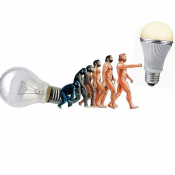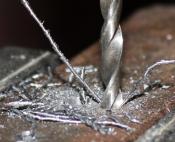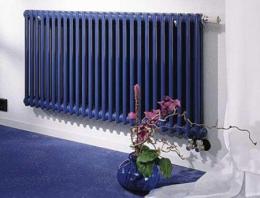Search
Login
Heating radiators for the home, types of heating radiators, expert advice on how to choose the right
Not so long ago, 20-30 years ago, when installing steam or water heating systems, installation of exclusively cast-iron radiators was used. Today, the market segment engaged in the sale of heating radiators, offers a choice of consumers numerous models of domestic and foreign production, made from a variety of materials. It is the abundance of products that is a good enough reason to study the detailed characteristics of each of the models - knowledge of the topic will make a rational choice.
Content:
- Characteristics of heating radiators
- Types of heating radiators
- Calculation of heating radiators
- Heating radiators for the home - choose the best option video
Characteristics of heating radiators
Each material used in the manufacture of radiators has a certain heat dissipation, and the temperature in the heated room depends on it in many respects. The second very significant point is the option of connecting a radiator. It is easy to guess that the temperature in the house during the heating season also depends on how many sections are installed in the rooms.
It should be noted that the cost of radiators depends on the material of manufacture, and on its quality and brand of the manufacturer.
Types of heating radiators

Heating batteries can be divided into several types, while certain characteristics of different models are taken into account.
aluminum radiators
If we take into account the material of manufacture, then the radiators can be aluminum, with high heat dissipation, withstanding pressure of about 16 atm, having a thermal power section within 192 watts. Aluminum radiators heat up quickly, can be very effectively used in arranging autonomous or centralized heating systems.

The disadvantages of aluminum products include a high level of their sensitivity to the chemical composition of water and pressure drops in the system, which happen quite often. An increased level of acidity of the coolant can cause metal corrosion; over time, the section may clog and fail. It is possible to recommend the installation of aluminum radiators if the condition of the water in the heating system is subjected to constant chemical monitoring.

It is also necessary to take into account the negative effect obtained from the high thermal power of aluminum products - raising too quickly the warm air coming from the batteries can lead to a large difference in the temperature of the floor and ceiling.
Before installing the heating system, you will need to perform an accurate calculation of the radiators, otherwise there is a risk of having a cold floor in the room.
cast-iron radiators, their features

Cast-iron models are a classic version, the thermal power of their sections is about 100-160 W, the working pressure is in the range from 10 to 15 atm. In today's market, cast-iron products are represented by radiators of a completely modern design. The performance of cast-iron batteries will be optimal at a carrier temperature of up to +150 C. Specialists recommend choosing cast-iron heating batteries for installation in cottages and public buildings, in apartments.

Cast iron radiators work with coolants of any type, the technology of their installation is quite simple. Among the disadvantages of cast-iron batteries are usually noted a lot of weight and the need for periodic painting.
bimetallic batteries - ideal for an office or apartment with central heating

Radiators can be bimetallic, having a thermal power section of the order of 200 watts, operating at a pressure of 35 atm. Bimetal radiators have a complex structure - their inner part is a core made of steel, the external fins are made of aluminum. Aluminum heats up much faster than steel, which helps to improve the thermal performance of the radiator.

It is advisable to use bimetallic radiators in office rooms or apartments with central heating, it makes no sense to install them in private houses with autonomous heating systems.
Among the positive qualities of bimetallic products should be remembered:
- high strength
- resistance to chemical impurities located in the coolant,
- light weight.
Among the shortcomings we name a slightly reduced, due to the steel core, heat transfer and a fairly high cost.
Among the bimetallic radiators are copper-aluminum models having a working pressure of up to 30 atm and a thermal power of 240-440 watts. The material for the manufacture of the cores of such radiators is copper, aluminum is used for fins. Advantages of such radiators: copper is not oxidized by the coolant and has excellent heat transfer. Problems during operation can be caused by poor soldering of copper. The disadvantages of copper-aluminum models include their high cost.
steel radiators for a private house
They do not consist of sections, but are produced by a ready-made kit. Steel radiators are characterized by the power of the entire set, it depends on the dimensions of the radiator and can be 450-7500 watts. Steel radiators can be operated at a pressure of 6 - 8.7 atm.

The steel radiator is two welded metal sheets with channels designed to pass the coolant. The advantages of such batteries are a large surface area, which allows for very fast heating, as well as the ability to work efficiently at a lower coolant temperature.
The internal surface of steel radiators is slightly susceptible to oxidation from water of insufficient quality, their service life is long, and their insignificant dimensions allow installation even under narrow window sills. Steel radiators are especially effective when installed in rooms of a private house with wide window openings - panel radiators are able to completely block the access to the room of cold air coming from the surface of the windows.
Among the shortcomings of steel products should be noted:
- low working pressure
- susceptibility to corrosion
- fear of mechanical damage.
It is recommended to resort to the installation of steel radiators in private houses with a small area or in city apartments with autonomous heating.

Installation of steel heating batteries involves the installation of shutoff valves, which allows filling the radiator with coolant. A radiator that is not filled with water will rust very quickly.
Companies manufacturing steel heating devices do not recommend planning their installation in rooms with high humidity, such as baths, pools, bathrooms.
Experts recommend flushing steel radiators every three years of operation - this will help to avoid slagging of the heating system of a private house.
Steel panel radiators are among the most budgetary options.

Tubular models, with the same characteristics, but more attractive and sophisticated design have a higher cost.
Connection of heating radiators can be lateral or lower.
Calculation of heating radiators
Before buying radiators, you should also correctly calculate their quantity. In order not to delve into the topic and simplify the calculation as much as possible, they often resort to a very simple formula, which assumes that in order to obtain the optimum room temperature, it is enough to install 0.5 sections of batteries for each square meter of its area, i.e. in order to heat a room of 12 sq.m, 6 sections will be needed. Experts recommend adding another section to the result, especially if the insulation systems for windows, walls and doors do not differ in special quality, or you often have to use the door in the room.

Specialists use a more complex calculation, taking into account the many nuances. However, such calculations provide more thorough data on the amount of thermal energy that will be required to warm the room to the desired temperature.
With this calculation, the type of room is taken into account:
- to heat 1 sq. m of the room in a panel house, 41 W of heat energy will be required,
- to warm the room in a house made of brick, insulated and with double-glazed windows, only 34 W is required,
- for houses built according to modern energy-saving projects, to obtain the same temperature, only 20 W of heat energy will be needed.
You will also need to calculate the volume of the heated room, for this they find the product of the width, length and height of the room. Next, taking into account the type of house, the necessary amount of thermal energy is required, which will be required for heating.
Experts recommend: if the doors to the neighboring room are constantly open, then when calculating the radiators, the cubic capacity of both rooms should be added. After performing the calculations, you can proceed with the selection of heating radiators.
Heating radiators for the home - choose the best option

Among the advantages of a private house is always called the possibility of creating an autonomous heating system, when calculating which it is possible to take into account all the desires of the owners of the house. When drawing up an individual project for heating a private house, there are wider possibilities for using different models of radiators, the reason for this is a number of positive characteristics that distinguish closed heating systems of private houses from centralized heating systems:
- possibility of operation at low pressure,
- the absence of water hammer allows you to expand the range of suitable for use heating devices,
- the ability to maintain a certain level of acidity of water and the ability to control it.
Given the above points, it can be concluded that the choice of heating radiators for a private house should be given:
- heat transfer coefficient,
- value for money.
Experts say that radiators of any kind and made of any material can be used when installing a closed heating system. Of course, at the same time it is necessary to consider in detail the characteristics of products from each of the popular manufacturers.
Products from a German company Zehnder - These are radiators with excellent design, often they are used for heating office, public and commercial premises, in the arrangement of which the attractive design of each element of the decoration of the premises plays a special role.

Steel is used in the manufacture of Zehnder radiators; products of this company are characterized by high efficiency, reliability, ease of installation and the ability to easily clean the surface of the radiator from dust. To adjust the volume of the coolant in the radiators, automatic thermostats are used.
Panel radiators Kermi made of steel, can withstand a fairly high working pressure, within 9 atm, for a short time - within 15 atm. It is quite possible to use such heating radiators for an apartment, even on the lower floors of apartment buildings.

The appearance of such products is quite attractive, they are worthy not only to heat the room, but also serve as an element of its design. The positive aspects include the coloring of radiators with special paints that do not contain formaldehydes and are able to withstand temperatures up to +110 C.
Aluminum radiators are fully consistent with Russian GOSTs and European standards. Calidor.

They are distinguished by good adaptation to operation in the conditions characteristic of Russia. Aluminum models are quite suitable for installation in apartments located on the upper floors of multi-storey buildings, where the coolant temperature is lower than on the lower floors. Aluminum allows to obtain maximum heat transfer at a relatively low carrier temperature. Attractive for the user is the low cost of aluminum models.
Excellent characteristics and high resistance to aggressive media are bimetal heating radiators for an apartment from the company Royal thermo.

Corrosion-resistant high-grade steel, which is used in their manufacture, significantly extends the life of the bimetallic device.
The absolute champion in the ratio of thermal power and internal volume among heating radiators are batteries from the company Regulus - a thermal power of 2 kW is provided by the circulation inside the device of only 0.8 liters of coolant.

To achieve maximum temperature, the device will require several minutes.

Regulus radiators with a low level of thermal inertia will be an ideal option for arranging a heating system in non-residential premises, in which maintaining a certain temperature is required for several hours, and the rest of the time the heating devices operate with minimal power.





